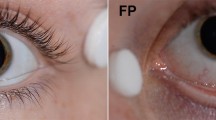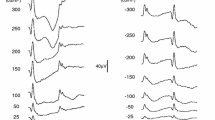Abstract
The bipolar Burian-Allen electrode represents the International Society for Clinical Electrophysiology of Vision standard for recording the electroretinogram. With prolonged recording there is a high risk of corneal abrasion from the electrode, while alternatives such as gold foil electrodes or fibers represent less risk. The standards require that alternative electrodes be demonstrated to give equivalent waveform and amplitudes. Electroretinograms were recorded with the bipolar Burian-Allen electrode and four alternative electrode configurations: a unipolar Burian-Allen electrode, a bipolar and monopolar gold foil electrode and a Dawson, Trick and Litzkow fiber electrode with all other recording conditions identical. The results represent a guide for comparisons of electroretinograms between studies using these electrodes. Recordings were made from two subjects for all five electrode configurations and six additional subjects with unipolar gold foil and bipolar gold foil electrodes alone. Flash stimuli over a range of intensities from full intensity to — 1.5 log units were used. Recordings were repeated in the one session and on a subsequent session to provide test-retest reliabilities. Significant (p < 0.0001) differences in b-wave amplitude resulting from electrode type and intensity were demonstrated. The unipolar Burian-Allen and unipolar gold foil electrodes produced the greatest amplitude responses. The alternatives to the bipolar Burian-Allen electrode were equally or more reliable. The Dawson, Trick and Litzkow electrode produced lower-amplitude response than the bipolar Burian-Allen electrode but was the only one with significantly greater between-session reliability.
Similar content being viewed by others
Abbreviations
- BA:
-
Burian-Allen
- DTL:
-
Dawson, Trick and Litzkow
- GF:
-
gold foil
- LU:
-
log units
References
Marmor MF, Arden GB, Nilsson SE, Zrenner E. Standard for clinical electroretinography. Arch Ophthalmol 1989; 107: 816–9.
Lawwill T, Burian HM. A modification of the Burian-Allen contact lens electrode for human electroretinography. Am J Ophthalmol 1966; 61: 1506–9.
Burian H, Allen L. A speculum contact lens electrode for electroretinography. Electroencephalogr Clin Neurophysiol 1954; 6: 509–11.
Henkes H, van Balen TM. Techniques of recording of the hitherto unrecordable ERG in the human eye (1959). quoted by: Sundemark E. ERG recording with different types of contact glass. Acta Ophthalmol Suppl 1962; 70: 62–9.
Sundmark E. ERG recording with different types of contact class. Acta Ophthalmol Suppl 1962; 70: 62–9.
Cringle SJ, Alder VA, Brown MJ, Yu DY. Effect of scleral recording location on ERG amplitude. Curr Eye Res 1986; 5: 959–65.
Gavriysky V. Erfahrungen mit einer neuartigen Elektroretinographie-Elektrode beim Menschen. Pflugers Arch Ges Physiol 1965; 284: 285–6.
Borda RP, Gillam RM, Coats AC. Gold coated Mylar (GCM) electrode for electroretinography. Doc Ophthalmol Proc Ser 1977; 15: 339–43.
Arden GB, Carter RM, Hogg C, Siegel IM, Margolis S. A gold foil electrode: extending the horizons for clinical electroretinography. Invest Ophthalmol Vis Sci 1979; 18: 421–6.
Aylward GW, McClellan KA, Thomas R, Billson FA. Transient corneal changes associated with the use of gold foil electrodes. Br J Ophthalmol 1989; 73: 980–4.
Dawson WW, Trick GL, Litzkow CA. Improved electrode for electroretinography. Invest Ophthalmol Vis Sci 1979; 18: 988–91.
Dawson WW, Trick GL, Maida FM. Evaluation of the DTL corneal electrode. Doc Ophthalmol Proc Ser 1982; 31: 81–8.
Vaegan. An improved method of constructing pattern electroretinogram electrodes. Doc Ophthalmol Proc Ser 1984; 40: 287–93.
Prager TC, Saad N, Schweitzer FC, Garcia CA, Arden GB. Electrode comparison in pattern electroretinography. Invest Ophthalmol Vis Sci 1992; 33: 390–4.
Arden GB, Carter RM, Hogg CR, Powell DJ, Ernst W, Clover GM, Lyness AL, Quinlan MP. A modifed ERG technique and the results obtained in X-linked retinitis pigmentosa. Br J Ophthalmol 1983; 67: 419–30.
Author information
Authors and Affiliations
Rights and permissions
About this article
Cite this article
Hennessy, M.P., Vaegan Amplitude scaling relationships of Burian-Allen, gold foil and Dawson, Trick and Litzkow electrodes. Doc Ophthalmol 89, 235–248 (1995). https://doi.org/10.1007/BF01203377
Accepted:
Issue Date:
DOI: https://doi.org/10.1007/BF01203377




